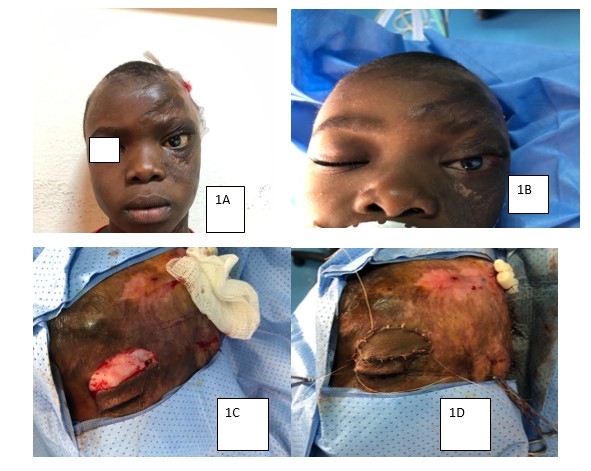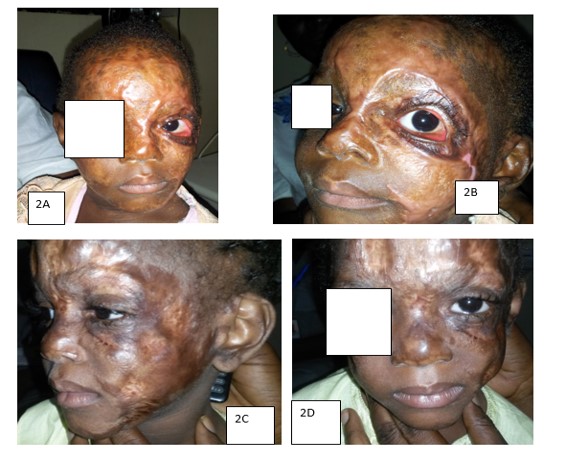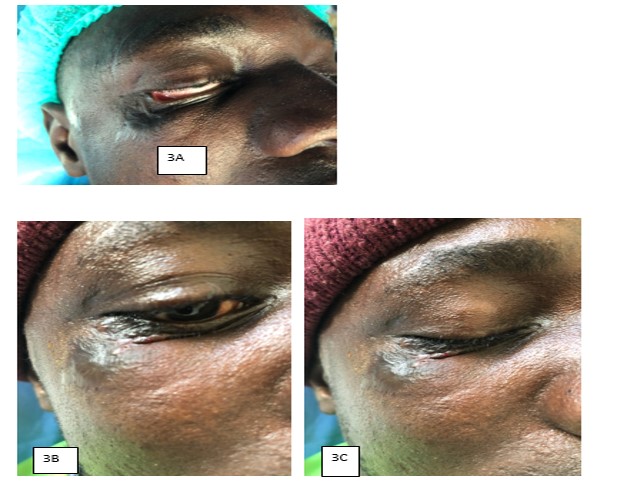Journal of Surgery and Insights
ISSN 2652-4643
Case Report
Surgical Treatment of CicatricialEctropion: Apropos of 32 Cases
Ndiaye Lamine1*, Ndiaye Aïnina1, Touré Silly2, Foba Mamadou Lassana1 and Sankalé Anne-Aurore1
1Department of Plastic Surgery, Aristide Le Dantec Hospital, Senegal
2Department of Maxillo-Facial Surgery, Aristide Le Dantec Hospital, Senegal
*Corresponding author:LamineNdiaye, Department of Plastic Surgery, Aristide Le Dantec Hospital, Senegal, Tel: +221 777164949; Email: drlndiaye@yahoo.fr
Citation: Ndiaye L, Ndiaye A, Toure S, Foba ML, Sankale AA (2020) Surgical Treatment of CicatricialEctropion: Apropos of 32 Cases. J Surg Insights: JSI-100011
Received date: 07 February, 2020; Accepted date:14 February, 2020; Published date: 21 February, 2020
Abstract
Background: Cicatricialectropionis most common and burn aetiologia are more common in our daily practice. It has both aesthetic and functional concern. Ectropion treatment is surgical and skin graft is most common procedure. The aim of this study was to assess our management of cicatricialectropion.
Patients and Method:We carried out a retrospective study for a period of 19 years during which 32 patients were recorded. None cicatricialectropion were exclude. Ophthalmic evaluation was required for patient before surgery. Procedures performed were scar releasing and full thickness skin graft, local flaps.
Results:These were 12 men and 20 women aged 23.4 years on average [2 - 52 years]. The ectropion was secondary to a thermal or chemical burn in 19 cases, trauma in 9 cases, skin infection in 3 cases. The duration of ectropion was on average 5 months [3 months to 2 years].
The ectropion was intrinsic in 29 patients and extrinsic in 3 patients.Isolated involvement of the lower eyelid was noted in 12 patients and that of the upper eyelid in 7 cases. Simultaneous involvement of both eyelids of the eye was noted in 5 patients. Seven patients had an ophthalmological assessment and follow-up. Visual impairment was found in 3 patients and in two cases it was complete blindness. Sixteen patients were operated of which 7 patients undergone local flap and 9 patients was treated by scar release andthe loss of substance was covered by full thickness skin graft. Complete eyelid occlusion was achieved in 13 cases and three patients had residual ectropion. Two patients among these tree patients had additional procedures by kin graft.After an average follow-up of 6 months, 14 patients had a complete eyelid obstruction and two patients presented discrete residual ectropion.
Conclusion: Burn contracture is the most common aetiologia in cicatricleectropion. Surgery must be planned earlier to avoid ocular impairment. Scar release and full thickness skin graft gives good result in severe cases.
Keywords:Cicatricleectropion; Local flap; Surgery; Skin graft
Introduction
Ectropion is a situation characterized by an eversion of the eyelid. It can be of senile or scarring origin. Cicatricleectropion are more frequent sequelae of peri-orbital region in victims of burns [1,2]. Other scarring causes may exist including trauma, infection or surgery. The major consequence is the lack of palpebral occlusion, especially during sleep, resulting in tearing, keratitis which can cause functional loss of the eye, infection, obstruction of the lacrimal ducts and cosmetic disgrace. Treatment should be planned quickly to avoid these complications. Numerous procedures have been described including skin grafting and local flap.
The purpose of this study was to evaluate the results of the management of ectropion of scar origin in our department.
Patients and Methods
We carried out a retrospective study going fromJanuary2000 to December 2019. Thirty-two patients with different causes of cicatricleectropion were include. Other causes of ectropionwere excluded. Data recording was made with clinical files as well as photography. After accurate clinical evaluation, procedure was done under general anesthesia. In case of skin grafting, the lids were sutured together until days 5th where the tie-on dressing was removed.Stiches were removed within 10 days and scar massage was allowed in days 21th.The parameters studied were epidemiological, clinical and therapeutic.
Results
These were 12 men and 20 women aged 23.4 years on average [2-52 years]. The ectropion was secondary to a thermal or chemical burn in 19 cases, trauma in 9 cases, skin infection in 3 cases. The duration of ectropion was on average 5 months [3 months to 2 years].
The ectropion was intrinsic in 29 patients and extrinsic in 3 patients.Isolated involvement of the lower eyelid was noted in 12 patients and that of the upper eyelid in 7 cases. Simultaneous involvement of both eyelids of the eye was noted in 5 patients. Seven patients had an ophthalmological assessment and follow-up. Visual impairment was found in 3 patients and in two cases it was complete blindness. Sixteen patients were operated of which 7 patients undergone local flap and 9 patients was treated by scar release and the loss of substance was covered by full thickness skin graft. Complete eyelid occlusion was achieved in 13 cases and three patients had residual ectropion. Two patients among these tree patients had additional procedures by kin graft.
After an average follow-up of 6 months, 14 patients had a complete eyelid obstruction and two patients presented discrete residual ectropion.
Discussion
Facial burns are most common aetiologiasof ectropion in our context.Among them flame and caustic chemicals was mostly encountered. These aetiologias are known to lead severe sequels to the deepness of the lesions. Most burns result from the action of heat and not from direct action of fire, fluids or chemicals. The severity and extent depend on the nature, intensity and duration of exposure to the thermal source [3-5].According to Vana[6], periocular area and lids are frequently affected with facial burns, ranging from 7.5 to 20% of all burn cases.
These scars begin to exert traction on the eyelid that by having tissues with low resistance, are pulled toward the scars, causing the ectropion[5,7]. Eyelid retraction and ectropion are more frequent sequelae of peri-orbital region in victims of burns [1,2]. All the cases of cicatricleectropionnoted in our study was due to the unsuitable management of acute burns. The lack of ocular protectionexposes the eye to multiple attacks that can lead to a more or less complete decrease in vision[8]. In our study, tree patients of vision and one patient had complete loss of vision and none of them had initial ophthalmic care or follow up. These complications can be sometime avoided becauseinitial involvement of the globe with thermal burns is unusual. Protective mechanisms such as the blink reflex, Bell’s phenomenon, and protective movements of the head and arms to avoid the source of the burn all serve to protect the globe[9].
Epidemiologically, women and children under the age of 10 make up a significant portion of our study population. This can be explained by the fact that burns occurred in a context of a domestic accident where women and children are most exposed. Treatment of ectropion should be planned as soon as possible to avoid prolonged exposure of the eyeball, which can cause functional and esthetic periorbital disorders.The indications for surgical release of ectropion are corneal exposure or eversion of the lacrimal punctum so as to disrupt its drainage function. This should be performed as soon as corneal exposure is recognized, ifat all possible because delay can lead to further complications[10]. Numerous surgical techniques have been described for ectropion management. The most common is the skin graft, because the main cause of the ectropion is the lack of local tissues, due to contraction of the skins result of burns and skin grafts. Regardless of the type of graft performed the recurrence of the ectropion may reach 30% whether in the acute phase of the treatment or not. In partial thickness skin graft this index is bigger [3,11]. It is always necessary to lengthen anterior lamella with free skin grafts[1,3,12].Difficult situation can be found in extended burned patient the widespread involvement of the skin and the difficulty in finding diseasefree area for transplantation, managing with ectropion in these patients is quite hard. Commonly used sites are the arm, groin, postauricular regions and alternatively prepuce[13,14]. In our practice we always use full skin graft from the groin because of the risk of keloids formations in the head and region. In addition, there is more skin laxity that allows large skin harvesting for both upper and lower eyelid reconstruction and the scar is easily
hidden. Method of choice of the graft type has been much debated question; however, sufficient number of studies reported good results and significantly less reoccurrence rate of cicatricleectropion with full-thickness skin grafting (FTSG) due to its presence of more dermis and subsequent less contraction. In case of incapability of obtaining FTSG [15], a split-thickness skin grafting (STSG) can be used [16].The use of local flaps must be preferred whenever possible, since the recurrence rates are substantially smaller [2,17]. In lower lid ectropion, hetero-palpebral flap from the upper lid, if not involved can be a good option incaseof blepharochalasis. The flap is safe and the defect lid is replaced with the same skin.In some situation lower lid fixation may be necessary. The techniques of canthoplasty and canthopexy are little used in burn victims since they are little efficient in more severe ectropion, commonly found in cases of burns [18-20]. In these patients the combination between skin graft and canthopexy or canthoplasty are more efficient than isolated procedures [21].
We did have some case of residual ectropion due to full-thickness skin graft retraction.It occurred in two patients who had caustic chemicals burn(Figure 1-3).Thisis more likely with split-thicknessgrafts and with extensive third-degree burns of the face and incomplete cicatrix release or inadequategraft size may contribute to ectropionrecurrence [22].
Conclusion
Facial burn is the most common cause of ectropion. This can lead to severe complication if treatment is not planned earlier. Scar release and full-thickness skin grafting give best results and is reproductible. Local flap can be also performed above all in linear retraction.

Figure 1: Reconstruction upper left eyelid by skin graft.
Figure: 1A and 1B: Pre-operative view.
Figure:1C: Loss of substance after scar release,
Figure:1D: Eyelid skin grafted.

Figure: 1E, F: Post-operative view.

Figure 2: Bilateral ectropion reconstructed by skin graft.
Figure: 1A and 1B: Pre-operative view upper and lower eyelid ectropion.
Figure: 2C and 2D: Post-operative result (1year follow up).

Figure 3: Lower eyelid ectropion treated by V-Y flap.
Figure: 3A: Pre-operative view, lower ectropion
Figure: 3B and 3C: Post-operative result
Citation: Ndiaye L, Ndiaye A, Toure S, Foba ML, Sankale AA (2020) Surgical Treatment of CicatricialEctropion: Apropos of 32 Cases. J Surg Insights: JSI-100011